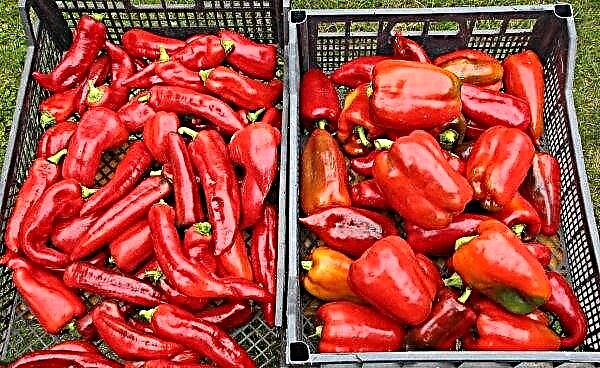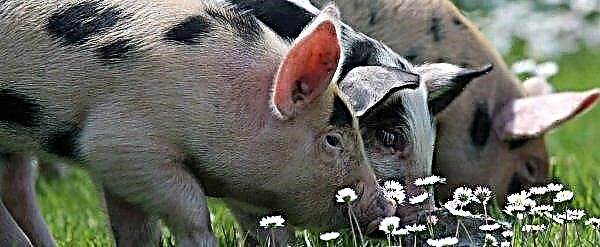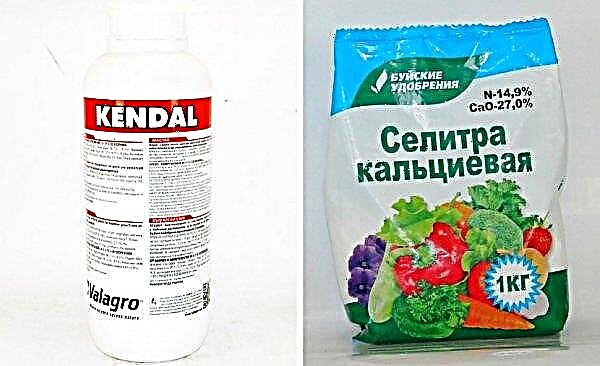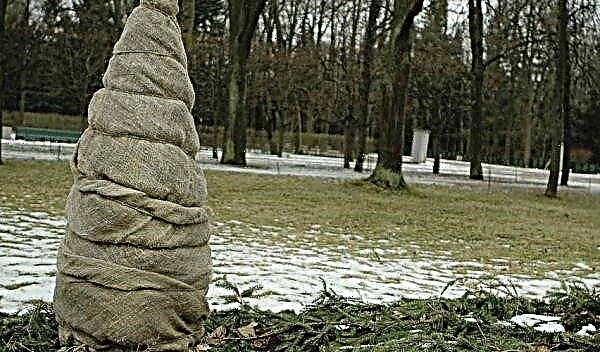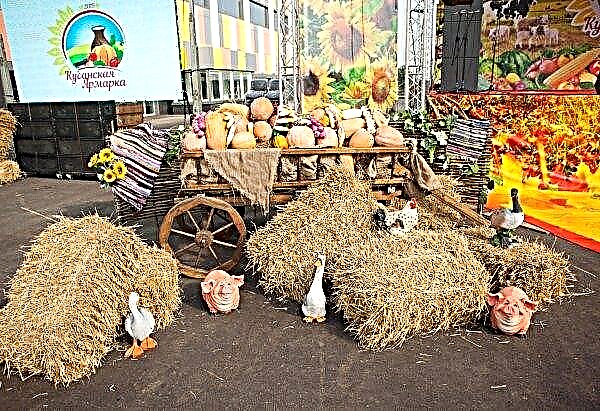The Rocambole garlic is immediately remembered for its piquant rich taste and large size. This type of garlic comes from Central Asia, but grows well in other countries with moderately warm summers. It is unpretentious in cultivation and care, has useful properties and decorates the garden during flowering. The description of Rocambole, the details of its planting and cultivation are discussed further in the article.
Description and useful properties
The Rocambole garlic has gained popularity in many European countries. Due to its gigantic head size, it is often called "elephant garlic."
Did you know? In Mediterranean cuisine, whole heads of Rocambole are baked and served as an independent hot dish.
A list of key plant characteristics is given below.
- Rocambol is a perennial herb and belongs to the Liliaceae family.
- The upper part is similar in appearance to leeks. It consists of a thick stem (arrow) with dense leathery leaves growing on it.
- The height of the ground part of the plant can reach 1.5 m.
- The leaves are saturated green, have a matte coating. The thickness of the leaves is 1-2 cm, the length is up to 60 cm.
- The diameter of the Rocambole bulb is 6–10 cm. It contains from 2 to 6 cloves.
- Each clove is “packed” in a hard flake of beige or purple color.
- All teeth are in one head and covered with a white scaly shell with small lilac veins.
- The weight of one head is from 200 to 300 g, depending on climatic conditions and caring for the plant.
- The taste of Rocambole is characterized by piquancy and pungency without bitterness. There is no specific smell.
- During the flowering period, the beds with Rocambole turn into flower beds with spherical inflorescences from small lilac flowers on the arrows.
- The seeds of the plant do not ripen; the inflorescences are sterile.
- Garlic propagates with teeth or children, which are around the bottom in the soil and act as seeds.
- In the first year of cultivation, the “Rocambole” bulb consists of one large child (single-tooth), weighing about 45 g. If you plant it again, then in the second year the head will already be divided into cloves.
- The bulb of garlic reaches its largest size only from the third year of cultivation.
- The yield of "Rocambole" is about 3 kg per square meter of beds.
- The heads are not kept fresh for long, so they are pickled, salted or dried for use as a seasoning.

- The Rocambole garlic is very useful for the human body:
- stimulates digestion and causes appetite due to a spicy pungent taste;
- strengthens the nervous system due to the high content of B vitamins;
- contributes to the healing of the body, as it contains useful micro and macro elements;
- helps to strengthen muscles due to the content of carotene;
- It is a good prophylactic to combat pathogens and viruses due to the content of ascorbic acid and volatile;
- favorably affects the cardiovascular system, dilates blood vessels and lowers blood cholesterol;
- strengthens the immune system due to the content of vitamins of the PP group.
Important! The Rocambole garlic is contraindicated in young children.
But in some cases, “Rockambol” can be harmful to the body. It can not be eaten with diseases of the digestive tract, liver and gall bladder, as well as during pregnancy.
Advantages and disadvantages
- The list of the main advantages of "Rocambol" include:
- large head size;
- comparative unpretentiousness in leaving;
- useful composition and medicinal properties of garlic;
- special piquant taste.
- The plant has some disadvantages:
- a two-year growth cycle necessary to obtain a head consisting of teeth;
- low resistance to frost;
- tendency to fungal infections;
- may cause food allergies.
The rules for planting garlic
Before planting Rocambol, it is necessary to prepare the planting material, as well as choose a suitable place for cultivation and prepare the beds for growing this plant. When choosing a place to land, you need to follow some rules:
When choosing a place to land, you need to follow some rules:
- the site should be sunny and open - Rocambole does not grow well in the shade;
- beds should be located from south to north;
- soil acidity should be neutral;
- you need to choose a site with loose soil so that garlic can sprout normally.
Did you know? The name of the famous American city of Chicago is translated from the language of local of the Indians like wild garlic.
When the place for planting is chosen, for the "Rocambole" begin to prepare the beds.
- If the soil in the selected area is too heavy, sand is added to it.
- To achieve a neutral level of soil acidity, you can use lime or peat. Lime is used to treat soil with high acidity, and peat - alkaline soil.
- To saturate the soil with nutrients, humus or compost is applied as fertilizer.

It includes several main stages:
- Stratification of planting material - If they plan to plant garlic in the spring, then a month before planting, the teeth and children are placed in the refrigerator. This helps to improve germination.
- Cleaning planting material from the remains of the bottom and flakes - needed in order to facilitate the process of germination.
- Treatment of teeth and children from diseases and pests - planting material is soaked in a solution of potassium permanganate for several hours.
- The choice of the same size teeth and children of Rocambol - so that after the emergence of seedlings, neighboring plants are approximately the same in height and not obscure each other.
Important! During landing, prongs "Rockambol" must be buried in the ground to a depth 2-3 times the height of the tooth.
Rocambole garlic can be planted in spring or autumn. Each of these two landing options has its own characteristics.
Video: Rocambole garlic planting technology
Fall
Farmers who grow Rocambole recommend planting it in the fall to get a more abundant crop of large heads of garlic. Winter planting is carried out in late September or the first half of October. You need to skillfully choose the time to plant garlic somewhere 20 days before the onset of persistent frost. If you plant the Rocambole late, the plant will not have time to form a strong root system, and if you plant it too early, the teeth will have time to germinate before the cold snap.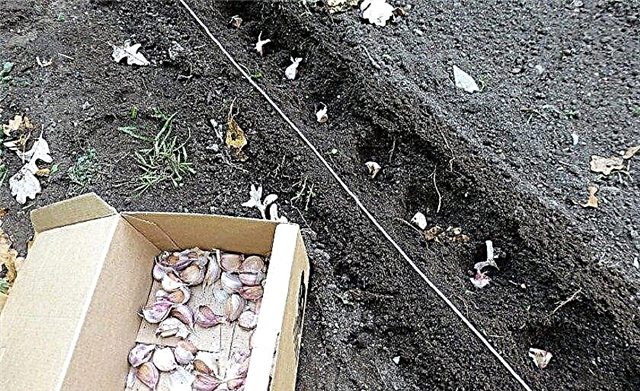 The list of step-by-step actions for landing “Rocambole” in the fall:
The list of step-by-step actions for landing “Rocambole” in the fall:
- Put phosphate-potassium fertilizers into the soil and dig it to a depth of 15–20 cm.
- Make long furrows with a depth of 8-10 cm (depending on the size of the teeth used for planting). If the soil is dry - pour it with water.
- The distance between adjacent furrows should be 25-30 cm.
- Place planting material into the furrow at a distance of 20 cm from each other. Fill the prongs with earth and, if necessary, pour water.
In the spring
Rocambole can be planted in early spring only after the soil warms up to +6 ° C. Depending on the geographic location of the region, this can happen in the second half of April or early May.
Step-by-step instructions for planting in the spring:
- Spread mineral fertilizers and ash into the soil. Dig the soil to a depth of 15–20 cm.
- Make furrows 6-8 cm deep (depending on the size of the planting material). If the soil is dry, it is recommended to water the furrows.
- The distance between adjacent furrows should be 25-30 cm.
- Place the teeth or garlic babies in the furrow at a distance of 20 cm from each other. Cover them with earth and pour water. If the soil at the time of planting is very moist, then you do not need to water the planted garlic cloves.
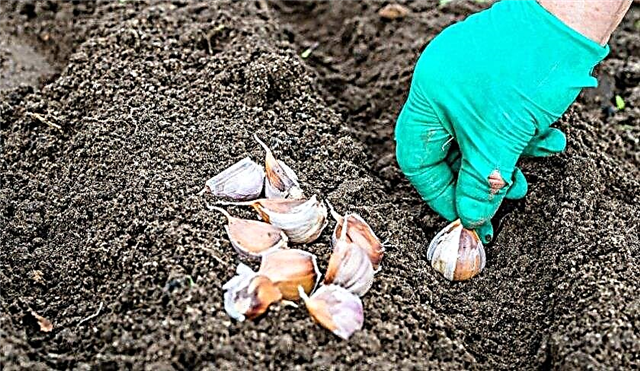
Further work
After planting the teeth, you need to wait until they germinate. If you plant the Rocambole in September or October, then during the winter, especially during severe frosts, landing may require shelter. To garlic overwinter safely, it is covered with a layer of straw, peat or spruce branches. With the onset of warm spring weather, the shelter must be removed so that the planting material does not overtake and sprouts.
Did you know? People began to eat garlic more than 6,000 years ago.
In the rest of the care, the autumn and spring plantings of garlic are no different from each other. During the flowering period, it is advisable to break off the arrows with inflorescences, so that the plant spends energy exclusively on the growth of the bulb. Also, for garlic, proper watering, fertilizing and regular weeding are important.
Watering
For good growth, the plant needs water. You need to water the Rocambol regularly, preventing the soil from drying out. It is especially important to provide the plant with water during the period of active growth and bulb formation - the size and quality of the crop will depend on proper watering during this period. But pouring garlic too much with water is not recommended, this can cause fungal diseases of the plant. During a long period of rains, care must be taken to divert excess water from the beds.
Here are some guidelines for watering Rocambole:
- it is best to use a drip type of irrigation;
- the water should be slightly warmed up in the sun, you can not water the plant with cold water - this causes fungal diseases;
- watering frequency - 2 times a week, in the second half of summer the plant is watered as the soil dries;
- on 1 m² of garlic, you need to spend 1 bucket of water.
Fertilizer application
For the normal development of a full and large head, Rocambol needs nutrients. The starting stock of necessary fertilizers is introduced at the planting stage. Next, you need to feed the plants in this way:
Next, you need to feed the plants in this way:
- nitrogen fertilizers - are introduced 10-14 days after the appearance of the first green shoots, and then again after a month. Promote active plant growth;
- phosphorus and potash fertilizers - are introduced in mid-summer, when the period of bulb formation begins. They help grow garlic with a large head consisting of large teeth;
- copper sulfate solution - applied once a season to prevent the occurrence of fungal infections of the plant.
Weed removal
Wild herbs are able to quickly absorb all the beneficial substances from the soil. Rockambol needs nutritious soil, so all weeds need to be removed. It is especially important to carry out weeding after the appearance of the first green shoots. Weeds grow much faster than garlic and can obscure shoots from the sun - this will inevitably lead to loss of crop.
Important! Weeding is useful to combine with loosening the soil.
Ideally, loosen the space between the rows after each watering. This procedure will help to avoid the appearance of dense crust and weeds around plants, and will also improve the air permeability of the soil around the roots.
Harvesting and storage
Harvest dates for garlic of this variety are determined depending on when the planting was carried out. If Rocambol was planted in autumn, then you need to harvest in July, and if planted in spring, garlic will ripen in September. When the lower leaves of the plant are completely dry, and the upper part of the stem has turned yellow - this means that it is time to dig up the heads from the ground. This must be done very carefully, and it is better to clean the bulbs from an earthen coma manually. The heads of garlic react strongly to mechanical damage, which subsequently leads to a quick spoilage of the crop.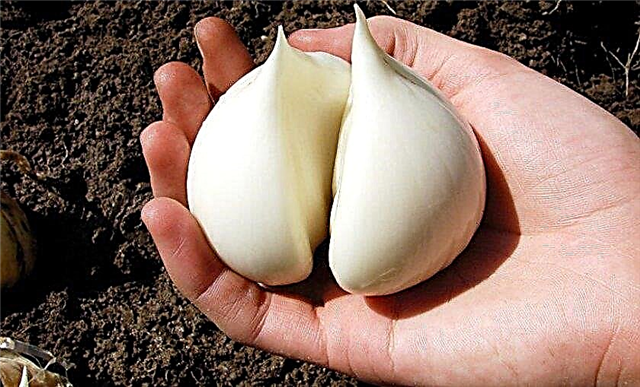 After the heads are removed from the soil, you need to leave them in the sun for a couple of hours. This will help to disinfect the garlic, as a result of which it will be better stored. Rocambol heads are recommended to be previously dried together with tops and roots. For this, plants are collected in bunches and hung on the wall. After 2-3 weeks, the roots are cut off from the plants; on the top of the head leave a small part of the stem, the rest of the tops also cut off. Garlic heads trimmed in this way are placed in plastic boxes.
After the heads are removed from the soil, you need to leave them in the sun for a couple of hours. This will help to disinfect the garlic, as a result of which it will be better stored. Rocambol heads are recommended to be previously dried together with tops and roots. For this, plants are collected in bunches and hung on the wall. After 2-3 weeks, the roots are cut off from the plants; on the top of the head leave a small part of the stem, the rest of the tops also cut off. Garlic heads trimmed in this way are placed in plastic boxes.
If the Rocambol harvest is stored at room temperature, it is able to not deteriorate for 3 months. To preserve the bulbs for up to 5 months, it is better to transfer them to a dry room with a temperature of +8 ° C. With careful implementation of all recommendations for planting and cultivation, Rocambol garlic gives the owner a generous harvest of large heads with a spicy taste and many beneficial properties for the body.


